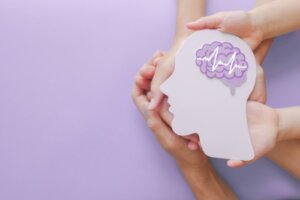Epilepsy in Adolescence


Written and verified by the psychologist José Padilla
Adolescence is a stage of development closely linked to epilepsy. This can be either because certain epileptic symptoms disappear during this phase or others appear. The prevalence of epilepsy in adolescents is estimated to be 3.2-5.5/1000 (Tirado, 2018).
Regardless of the factors that determine the onset or disappearance of epileptic syndromes in adolescence, the presence of this particular clinical picture requires professional attention. Indeed, this disorder requires it in all cases but, perhaps more especially at this stage, since it’s a vulnerable phase, both physically and emotionally.
Epilepsy in adolescents
Epilepsy is a disorder of the central nervous system. The electrical activity of the brain is disturbed which causes seizures or unusual behaviors and sensations. Its manifestation is heterogeneous and it depends on particular characteristics.
During epileptic seizures, some people stare for seconds, while others experience seizures caused by excessive electrical discharges in neurons. Due to the fact that epilepsy is the product of abnormal dynamics in the cerebral cortex, these seizures could affect any organic or psychological function in charge of brain activity.
Epilepsy affects adolescents both psychologically and socially. For example, their interactions with peers, educational and professional decisions, driving ability, and reproductive life are some of the affected areas. Moreover, research suggests that adolescents with epilepsy exhibit significantly higher levels of depression, obsessive symptoms, anhedonia, and social anxiety, compared to those without the disorder.
Furthermore, studies have also found that, among young people with epilepsy, high seizure frequency is linked with low self-esteem, and tonic-clonic seizures are linked with higher levels of depression. This analysis determined that low levels of knowledge about epilepsy correspond to higher rates of depression, lower self-esteem, and higher levels of social anxiety.
Symptoms
Among the symptoms and signs of epilepsy in the adolescent stage are:
- Muscular stiffness.
- Temporary confusion.
- Absence episodes.
- Loss of consciousness.
- Paroxysmal movements of the extremities.
- Psychological symptoms such as fear or anxiety about experiencing an episode.
These symptoms vary according to the type of epilepsy and the kind of seizures. Typically, adolescents with this condition experience the same type of seizures in each episode. Therefore, the symptoms will be similar each time.
Clinical classification of epilepsy
Depending on the origin of the shock, epileptic seizures are divided into focal and generalized.
Focal
Episodes in which the abnormal electrical activity is confined to a specific region of the brain. They manifest as follows:
- Complex partial seizures. Disturbances at the level of consciousness. Automatisms or stereotyped acts are frequent.
- Simple partial seizures. They develop without alterations in consciousness. They can be motor, sensitive, physiological, or psychological (depersonalization, fear).
- Secondarily generalized partial seizures. They’re generalized. In fact, they originate from the two previous types of seizures and extend over the two hemispheres of the brain.
Widespread
These episodes don’t have a localizable beginning. They occur with alterations of consciousness from the start. They’re as follows:
- Atonic seizure or a ‘drop attack’. There’s a loss of postural muscle tone. In effect, the sufferer’s muscles become suddenly floppy.
- Typical absences. Brief, sudden episodes of loss of consciousness.
- Tonic seizures. Brief contraction of the upper limbs. They cause stiffness.
- Clonic seizures. Jerky, repetitive, asymmetrical, and irregular muscle movements.
- Atypical absences. The same as the previous ones, but they have a lesser effect on consciousness.
- Myoclonic seizures. Sudden, recurrent, and brief muscle jerks. There’s a loss of consciousness. They usually affect the arms and legs
- Tonic-clonic seizures. They start with a loss of consciousness, then progress with muscle contractions throughout the body. Later, the clonic phase or convulsive movements occur. They end with a period of confusion of variable duration.

Types of epilepsy in adolescents
Adolescence is a period of life that encompasses the various ages at which different types of epilepsy usually start. For example:
Juvenile myoclonic epilepsy
This type presents with sudden convulsions in the extremities of the body, mainly the arms and legs. It’s characterized by myoclonus and, less frequently, generalized tonic-clonic seizures and absences. Seizures usually occur at the time of waking up or within a few minutes of doing so.
Juvenile absence epilepsy
This is of the generalized idiopathic type. It’s distinguished by an absence seizure that may be accompanied by myoclonus and generalized tonic-clonic seizures. Similarly, brief disturbances of consciousness occur along with generalized spike-wave discharges at three or more Hz on the EEG.
Epilepsy with generalized tonic-clonic seizures
This kind of adolescent epilepsy begins with a loss of consciousness and muscle twitching. It then goes through a phase of convulsive movements, ending with a period of confusion of variable duration. In generalized tonic-clonic seizures, the patient may make guttural sounds and exhibit irregular breathing.
Benign focal epilepsy of adolescence
This is a rare type of epilepsy. It begins between the ages of ten and 20. It’s characterized by focal motor or somatosensory seizures and is usually of short duration. It’s usually associated with a family history of epilepsy.

How to treat epilepsy in adolescents
The treatment of adolescents diagnosed with epilepsy is usually based on anticonvulsants. As the name suggests, they tend to prevent seizures. Some of these medications are:
- Phenytoin.
- Lamotrigine.
- Oxcarbazepine.
- Carbamazepine.
- Valproic acid.
The function of the anticonvulsant drug isn’t to intervene in the direct causes of the seizures, but to appease or prevent their manifestation. In other words, they attack the symptom, but not the basic problem that causes them. However, these drugs can have side effects such as:
- Dizziness.
- Vomiting
- Nausea.
- Rashes
- Double vision.
- Drowsiness.
- Hepatic injury.
- Headaches.
- Loss of coordination.
For the treatment of these effects, it’s advisable to consult the doctor who made the diagnosis. In the event that medicine doesn’t give the expected result, surgery is an option. In fact, doctors turn to this remedy when neurological exams and tests indicate that:
- The electrical discharges that are causing the seizures are focused on a specific part of the brain.
- The region of the brain to undergo surgery isn’t interfering with vital functions, such as language, motor skills, vision, and hearing.
However, if surgery presents high risks, guided stereotactic laser ablation could be an effective and viable treatment. In this procedure, doctors use laser technology to destroy the tissue where the seizures occur.
Alternative treatments
Other possible treatments for epilepsy in adolescents include vagus nerve stimulation, a ketogenic diet, deep brain stimulation, and receptive neurostimulation.
Finally, the adolescent may find it useful to receive psychological attention. This will help them understand that these crises are only a small part of their life and that they don’t have to limit their existence too much.
Adolescence is a stage of development closely linked to epilepsy. This can be either because certain epileptic symptoms disappear during this phase or others appear. The prevalence of epilepsy in adolescents is estimated to be 3.2-5.5/1000 (Tirado, 2018).
Regardless of the factors that determine the onset or disappearance of epileptic syndromes in adolescence, the presence of this particular clinical picture requires professional attention. Indeed, this disorder requires it in all cases but, perhaps more especially at this stage, since it’s a vulnerable phase, both physically and emotionally.
Epilepsy in adolescents
Epilepsy is a disorder of the central nervous system. The electrical activity of the brain is disturbed which causes seizures or unusual behaviors and sensations. Its manifestation is heterogeneous and it depends on particular characteristics.
During epileptic seizures, some people stare for seconds, while others experience seizures caused by excessive electrical discharges in neurons. Due to the fact that epilepsy is the product of abnormal dynamics in the cerebral cortex, these seizures could affect any organic or psychological function in charge of brain activity.
Epilepsy affects adolescents both psychologically and socially. For example, their interactions with peers, educational and professional decisions, driving ability, and reproductive life are some of the affected areas. Moreover, research suggests that adolescents with epilepsy exhibit significantly higher levels of depression, obsessive symptoms, anhedonia, and social anxiety, compared to those without the disorder.
Furthermore, studies have also found that, among young people with epilepsy, high seizure frequency is linked with low self-esteem, and tonic-clonic seizures are linked with higher levels of depression. This analysis determined that low levels of knowledge about epilepsy correspond to higher rates of depression, lower self-esteem, and higher levels of social anxiety.
Symptoms
Among the symptoms and signs of epilepsy in the adolescent stage are:
- Muscular stiffness.
- Temporary confusion.
- Absence episodes.
- Loss of consciousness.
- Paroxysmal movements of the extremities.
- Psychological symptoms such as fear or anxiety about experiencing an episode.
These symptoms vary according to the type of epilepsy and the kind of seizures. Typically, adolescents with this condition experience the same type of seizures in each episode. Therefore, the symptoms will be similar each time.
Clinical classification of epilepsy
Depending on the origin of the shock, epileptic seizures are divided into focal and generalized.
Focal
Episodes in which the abnormal electrical activity is confined to a specific region of the brain. They manifest as follows:
- Complex partial seizures. Disturbances at the level of consciousness. Automatisms or stereotyped acts are frequent.
- Simple partial seizures. They develop without alterations in consciousness. They can be motor, sensitive, physiological, or psychological (depersonalization, fear).
- Secondarily generalized partial seizures. They’re generalized. In fact, they originate from the two previous types of seizures and extend over the two hemispheres of the brain.
Widespread
These episodes don’t have a localizable beginning. They occur with alterations of consciousness from the start. They’re as follows:
- Atonic seizure or a ‘drop attack’. There’s a loss of postural muscle tone. In effect, the sufferer’s muscles become suddenly floppy.
- Typical absences. Brief, sudden episodes of loss of consciousness.
- Tonic seizures. Brief contraction of the upper limbs. They cause stiffness.
- Clonic seizures. Jerky, repetitive, asymmetrical, and irregular muscle movements.
- Atypical absences. The same as the previous ones, but they have a lesser effect on consciousness.
- Myoclonic seizures. Sudden, recurrent, and brief muscle jerks. There’s a loss of consciousness. They usually affect the arms and legs
- Tonic-clonic seizures. They start with a loss of consciousness, then progress with muscle contractions throughout the body. Later, the clonic phase or convulsive movements occur. They end with a period of confusion of variable duration.

Types of epilepsy in adolescents
Adolescence is a period of life that encompasses the various ages at which different types of epilepsy usually start. For example:
Juvenile myoclonic epilepsy
This type presents with sudden convulsions in the extremities of the body, mainly the arms and legs. It’s characterized by myoclonus and, less frequently, generalized tonic-clonic seizures and absences. Seizures usually occur at the time of waking up or within a few minutes of doing so.
Juvenile absence epilepsy
This is of the generalized idiopathic type. It’s distinguished by an absence seizure that may be accompanied by myoclonus and generalized tonic-clonic seizures. Similarly, brief disturbances of consciousness occur along with generalized spike-wave discharges at three or more Hz on the EEG.
Epilepsy with generalized tonic-clonic seizures
This kind of adolescent epilepsy begins with a loss of consciousness and muscle twitching. It then goes through a phase of convulsive movements, ending with a period of confusion of variable duration. In generalized tonic-clonic seizures, the patient may make guttural sounds and exhibit irregular breathing.
Benign focal epilepsy of adolescence
This is a rare type of epilepsy. It begins between the ages of ten and 20. It’s characterized by focal motor or somatosensory seizures and is usually of short duration. It’s usually associated with a family history of epilepsy.

How to treat epilepsy in adolescents
The treatment of adolescents diagnosed with epilepsy is usually based on anticonvulsants. As the name suggests, they tend to prevent seizures. Some of these medications are:
- Phenytoin.
- Lamotrigine.
- Oxcarbazepine.
- Carbamazepine.
- Valproic acid.
The function of the anticonvulsant drug isn’t to intervene in the direct causes of the seizures, but to appease or prevent their manifestation. In other words, they attack the symptom, but not the basic problem that causes them. However, these drugs can have side effects such as:
- Dizziness.
- Vomiting
- Nausea.
- Rashes
- Double vision.
- Drowsiness.
- Hepatic injury.
- Headaches.
- Loss of coordination.
For the treatment of these effects, it’s advisable to consult the doctor who made the diagnosis. In the event that medicine doesn’t give the expected result, surgery is an option. In fact, doctors turn to this remedy when neurological exams and tests indicate that:
- The electrical discharges that are causing the seizures are focused on a specific part of the brain.
- The region of the brain to undergo surgery isn’t interfering with vital functions, such as language, motor skills, vision, and hearing.
However, if surgery presents high risks, guided stereotactic laser ablation could be an effective and viable treatment. In this procedure, doctors use laser technology to destroy the tissue where the seizures occur.
Alternative treatments
Other possible treatments for epilepsy in adolescents include vagus nerve stimulation, a ketogenic diet, deep brain stimulation, and receptive neurostimulation.
Finally, the adolescent may find it useful to receive psychological attention. This will help them understand that these crises are only a small part of their life and that they don’t have to limit their existence too much.
All cited sources were thoroughly reviewed by our team to ensure their quality, reliability, currency, and validity. The bibliography of this article was considered reliable and of academic or scientific accuracy.
- Baker, G. A., Spector, S., McGrath, Y., & Soteriou, H. (2005). Impact of epilepsy in adolescence: a UK controlled study. Epilepsy & behavior : E&B, 6(4), 556–562. https://doi.org/10.1016/j.yebeh.2005.03.011
- Caldera, D. J., & Burneo, J. G. (2018). Epilepsia mioclónica juvenil. Revista de Neuro-Psiquiatría, 81(4), 250-256.
- Fuertes de Gilbert, B., López, R. y Gil, P. (s.f). Epilepsia. https://www.academia.edu/37767382/Epilepsia
- Macau, M. A., Centellas, M. F., de las Heras, M. V., Perín, M. C., Lladó, J. M., Gómez, I. M., & Palomar, E. E. (2011). Pronóstico a largo plazo de la epilepsia ausencia juvenil. Neurología, 26(4), 193-199. https://www.elsevier.es/es-revista-neurologia-295-articulo-pronostico-largo-plazo-epilepsia-ausencia-S0213485310002082
- Paolicchi J. M. (2002). Epilepsy in adolescents: diagnosis and treatment. Adolescent medicine (Philadelphia, Pa.), 13(3), 443–459.
- Rose GM, Tadi P. Social Anxiety Disorder. [Updated 2022 Oct 25]. In: StatPearls [Internet]. Treasure Island (FL): StatPearls Publishing; 2022 Jan-. Available from: https://www.ncbi.nlm.nih.gov/books/NBK555890/
- Tirado, P. (2018). Epilepsia en el adolescente. Adolescere, 6(1), 44-50. https://www.adolescere.es/epilepsia-en-el-adolescente/
- Ułamek-Kozioł, M., Czuczwar, S. J., Januszewski, S., & Pluta, R. (2019). Ketogenic Diet and Epilepsy. Nutrients, 11(10), 2510. https://doi.org/10.3390/nu11102510
This text is provided for informational purposes only and does not replace consultation with a professional. If in doubt, consult your specialist.







